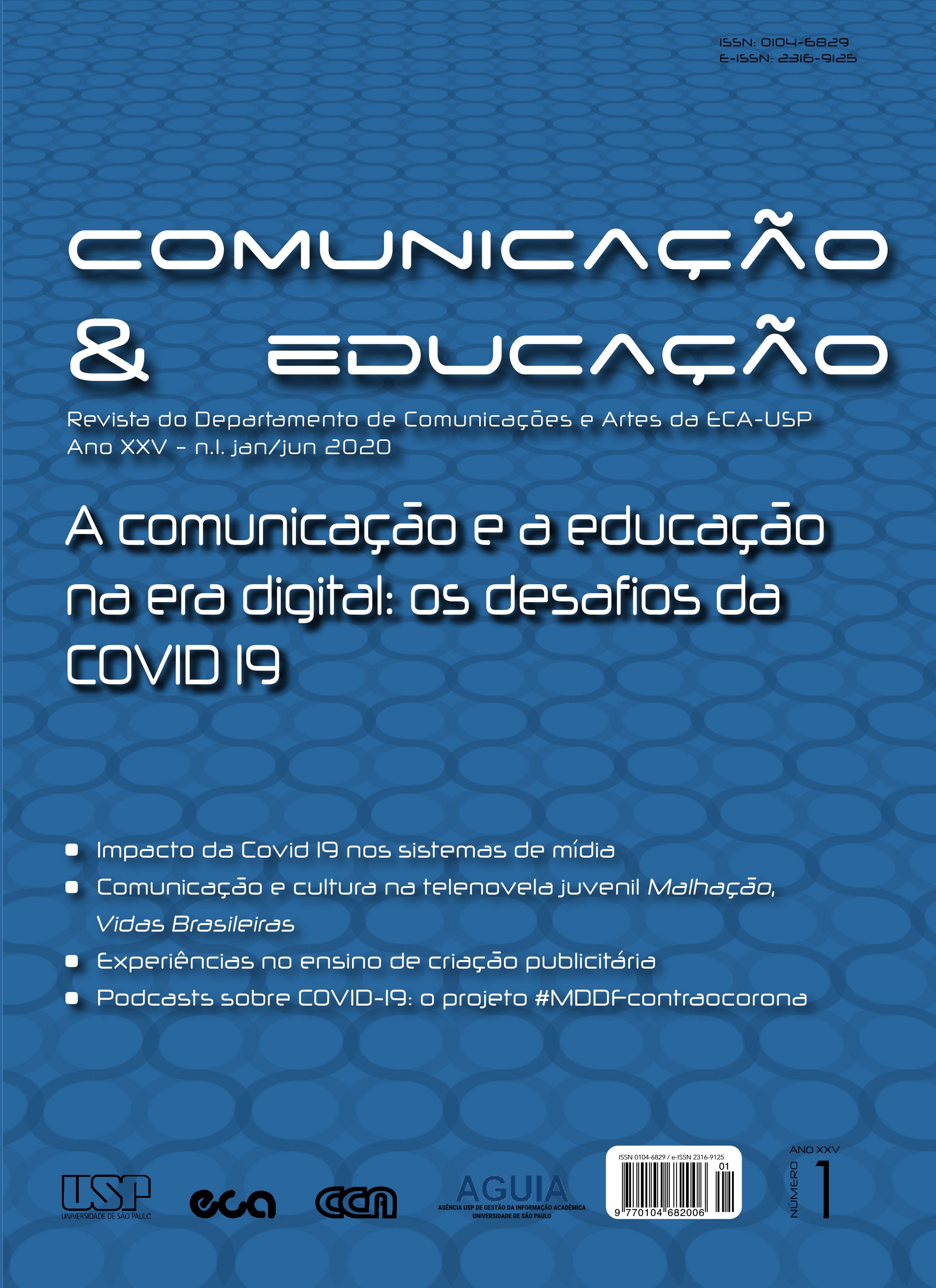Communication and culture in the juvenile telenovela: naturalism, nation and contamination of themes in Malhação: Vidas Brasileiras
DOI:
https://doi.org/10.11606/issn.2316-9125.v25i1p31-41Keywords:
Audiovisual, Television, Serial ficction, Telenovela, Juvenile narrativeAbstract
Malhação: Vidas Brasileiras was popular due to the social issues it addressed. Thus, this paper analyzes its communication dimensions and the cultural developments that can impact on the fruition of young viewers, based on the analysis of the cultural narratives of the plot. The adopted methodology merges the observation and interpretation methods, starting with the descriptions of some scenes of the product and comparing them to theories and discussions about its relevant phenomena. The theoretical framework that supports these readings includes Maria Immacolata Vassalo de Lopes (2009, 2014), Elizabeth Rondelli (1997), among other authors who talk about the telenovela and its relation to sociocultural interlacings. Among the results the generation of video games and social networks was shown to have a television product at its disposal, with elements of its sociocultural context: the traditional Brazilian telenovela, a formula consecrated in its imaginary and culture.
Downloads
References
DESIDÉRIO, Plábio Marcos Martins. Merchandising social e os códigos da imagem televisiva: a construção de significados na telenovela. Revista GEMInIS, São Carlos, v. 1, n. 1, p. 82-98, 2010. Disponível em: http://www.revistageminis.ufscar.br/index.php/geminis/article/view/10. Acesso em: 1º maio 2019.
HAMBURGER, Esther. Novela, política e intimidade: a construção da realidade. In: HAMBURGER, Esther. O Brasil antenado: a sociedade da novela. Rio de Janeiro: Jorge Zahar, 2005. p. 148-170.
HERGESEL, João Paulo. Carrossel de sentimentos: melodrama na telenovela do SBT. Fronteiras: estudos midiáticos, São Leopoldo, v. 19, p. 72-82, 2017. Disponível em: http://www.revistas.unisinos.br/index.php/fronteiras/article/view/12444. Acesso em: 1º out. 2020.
HERGESEL, João Paulo; FERRARAZ, Rogério. Melodrama infantojuvenil na televisão brasileira: análise estilística de Carrossel (SBT, 2012-2013). Conexão: Comunicação e Cultura, Caxias do Sul, v. 16, n. 31, p. 201-222, 2017. Disponível em: http://www.ucs.br/etc/revistas/index.php/conexao/article/view/5174. Acesso em: 18 abr. 2019.
LOPES, Maria Immacolata Vassalo de. Telenovela como recurso comunicativo. MATRIZes, São Paulo, v. 3, n. 1, p. 21-47, 2009. Disponível em: http://www.revistas.usp.br/matrizes/article/view/38239. Acesso em: 1º maio 2019.
LOPES, Maria Immacolata Vassalo de. Memória e identidade na telenovela brasileira. In: ENCONTRO ANUAL DA COMPÓS, 23., Universidade Federal do Pará, Curitiba, 2014. Anais […]. Brasília: Compós, 2014. Disponível em: http://compos.org.br/encontro2014/anais/Docs/GT12_ESTUDOS_DE_TELEVISAO/templatexxiiicompos_2278-1_2246.pdf. Acesso em: 1º maio 2019.
MARQUES, Angela Cristina Salgueiro. Telenovela e política: perspectivas e modos de abordagem. Revista Significação, São Paulo, v. 42, n. 44, p. 318-338, 2015. Disponível em: http://www.revistas.usp.br/significacao/article/view/102506. Acesso em: 1º maio 2019.
MARTÍN-BARBERO, Jesús. Latin America: cultures in the communication media. Journal of Communication, Oxford, v. 43, n. 2, p. 18-30, 1993. Disponível em: https://academic.oup.com/joc/article-abstract/43/2/18/4160017?redirectedFrom=fulltext. Acesso em: 1º maio 2019.
MARTÍN-BARBERO, Jesús. Dos meios às mediações: comunicação, cultura e hegemonia. 2. ed. Rio de Janeiro: UFRJ, 2001.
RONDELLI, Elizabeth. Realidade e ficção no discurso televisivo. Letras, Curitiba, v. 11, n. 48, p. 149-207, 1997. Disponível em: https://revistas.ufpr.br/letras/article/view/19016/12326. Acesso em: 1º maio 2019.
SADEK, José Roberto. Telenovela: um olhar do cinema. São Paulo: Summus, 2008.
THE INTERNATIONAL Format Awards. C21Media, Londres, 2019. Disponível em: https://www.c21media.net/the-international-format-awards-2019/. Acesso em: 1º maio 2019.
Downloads
Published
Issue
Section
License
Copyright (c) 2020 João Paulo Hergesel, Paula Regina da Silva Ferreira

This work is licensed under a Creative Commons Attribution 4.0 International License.
I authorize the publication of the submitted article and soon the copyrights to the magazine, in the printed and electronic version, if it is approved after the evaluation of the reviewers.
I understand that readers may use this article without prior request, provided the source and authorship are mentioned. Readers are not authorized to use this article for reproduction, in whole or in part, for commercial purposes.

































